
|
| Photo Credit: Evind Barstad Waaler |
When you're seven it seems that nothing is quite so spectacular as being better at something than your older sister. Or, at least, that's how it seemed to me when my sister would get so excited about playing (and beating me) at chess. But unmitigated success can really only last so long; our grandfather was a brilliant chess player who would have offered much more challenge, but he was far away! He came up with a creative solution to help him play chess with my sister through the miles- Correspondence Chess, otherwise known as a Play-by-Mail Game.
The basic idea of any Play By Mail Game, is that the players mail each other their move each time it is their turn, and then must wait for their opponent's move to be mailed back to them. In today's digital age this can seem a bit archaic- or, at least, something that might more efficiently (and, arguably more cost effectively) be done by email, chatrooms or even apps. But I'd argue there is something special about the time and dedication that such Play By Mail Games require. It can also really help to foster a relationship by sharing interests, as in the case of my sister and grandfather.
As with anything involving chess, Correspondence Chess has a large number of devotees, and therefore large organizations you can join to find new opponents and read up on rules.
However, the basic premise is pretty simple. With Correspondence Chess (or any play by mail game), the regular rules of the game are followed, excepting some rules about time regulations.
To play Correspondence Chess, you and your fellow player must decide several things before hand- mainly who will play the white pieces and who will play the black ones (this also decides who will send off the first move, since in chess the white pieces have the first move), and how long each person can have per move or number of moves (for example, most people allow for "thirty days of reflection time per ever ten moves" mean you've got to make ten moves within thirty days. You will also need to decide if "reflection time" counts the time your mail takes to travel or if it only counts the days from when you got your opponent's latest move to when you mailed back your latest counter-play). Also make sure to be clear that you are using the same terminology to explain your move, so that the other person does not get confused about where your pieces should be on the board.
Many people will also use special postcards to show moves, such as this one for international Correspondence Chess, or the one used by the U.S. Chess Federation.

Because Correspondence Chess is a game playing out over weeks if not months, it is important to be able to record past moves. Most people will also set up physical board in some quite place in the house. You could also keep a log or illustrated game.
Besides correspondence chess, there are a whole other bevy of possible games to play by mail. Backgammon, Checkers, Battleship, Stratego, and Tic-Tac-Toe immediately come to mind as ones that would be easy manage long distance. However, there is a wide range of games commonly played through the mail, including ones with multiple players. Those often require one person to work as a coordinator, so it might be best to look up a group to join. What games would you want to try playing through the mail?
For more information:
Play by Mail Games

It's a thing!
Reply Deletehow cool!
love this! My fiance and his grandfather play correspondence chess. They love it!
Reply DeleteOh that is so fun!
Delete